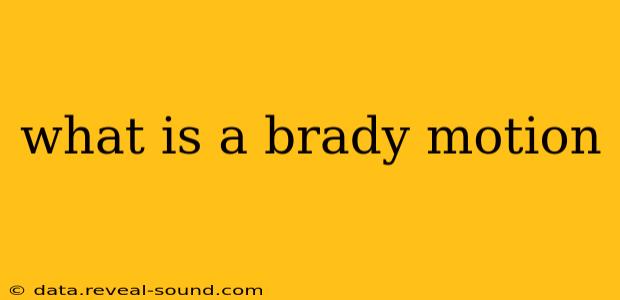A Brady motion, named after the Supreme Court case Brady v. Maryland (1963), is a crucial legal tool used in criminal cases to ensure a fair trial. It's a request made by the defense attorney to the prosecution, demanding the disclosure of any exculpatory evidence—evidence that could potentially exonerate the defendant or mitigate their guilt. This isn't simply about finding favorable evidence; it's about ensuring the prosecution's complete transparency and upholding the defendant's right to a fair trial. Understanding the implications and nuances of a Brady motion is vital for anyone involved in the American legal system.
What Evidence Must Be Disclosed in a Brady Motion?
The scope of a Brady motion is broad, encompassing a range of exculpatory evidence. This includes, but isn't limited to:
-
Evidence that directly contradicts the prosecution's case: This could be witness statements, forensic reports, or physical evidence that casts doubt on the prosecution's version of events.
-
Evidence that impeaches the credibility of prosecution witnesses: This refers to evidence that reveals biases, inconsistencies, or prior criminal records of witnesses, affecting their trustworthiness in court.
-
Evidence that supports the defendant's alibi or alternative theory of the case: This might involve evidence that places the defendant elsewhere at the time of the crime or presents a different scenario altogether.
-
Information about potential misconduct by law enforcement: This could include evidence of police brutality, coercion of witnesses, or suppression of evidence, all of which could impact the fairness of the investigation and subsequent trial.
What Happens if the Prosecution Fails to Disclose Brady Material?
The consequences of failing to disclose Brady material can be severe. If a conviction is obtained without the disclosure of material exculpatory evidence, the conviction can be overturned on appeal. This is a significant consequence, as it requires a retrial, potentially letting a guilty party go free. The prosecution's failure to uphold its Brady obligations undermines the integrity of the justice system and infringes upon the defendant's fundamental right to a fair trial. The severity of the sanction depends on the materiality of the undisclosed evidence; if it would have likely affected the outcome of the trial, the consequences are more severe.
How Does a Brady Motion Work in Practice?
A Brady motion is typically filed by the defense attorney well before the trial commences. The defense attorney will specifically request the disclosure of any exculpatory evidence known to the prosecution. The prosecution is then obligated to conduct a thorough review of their files and disclose any such evidence. This process often involves extensive legal wrangling, negotiations, and even court hearings to determine what constitutes "exculpatory" in a given case. The judge plays a crucial role in overseeing this process and resolving any disputes.
What is the Difference Between a Brady Motion and Other Discovery Motions?
While a Brady motion is a type of discovery motion, it's distinct in its focus. Other discovery motions seek broader access to evidence relevant to the case, while a Brady motion specifically targets exculpatory evidence that favors the defense. The obligation to disclose Brady material is constitutionally mandated and imposes a higher duty on the prosecution than other aspects of discovery.
How Does a Brady Motion Affect the Outcome of a Case?
The successful filing of a Brady motion can dramatically alter the course of a criminal case. It can lead to charges being dropped, plea bargains being renegotiated, or even the acquittal of the defendant if the newly disclosed evidence sufficiently undermines the prosecution's case. It serves as a crucial safeguard against wrongful convictions and underscores the importance of prosecutorial integrity in the pursuit of justice.
In conclusion, the Brady motion is a cornerstone of the American justice system, guaranteeing a fair trial by ensuring complete transparency on the part of the prosecution. Its impact can be profound, highlighting the critical role of exculpatory evidence in securing justice.
